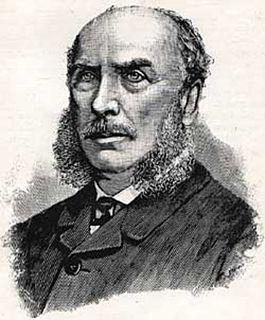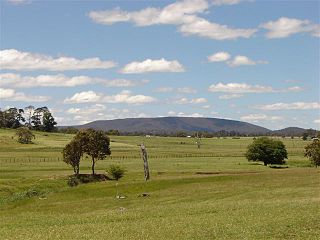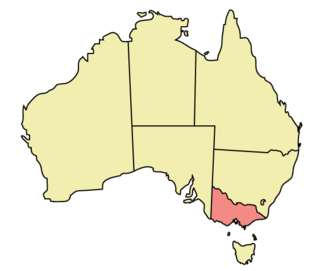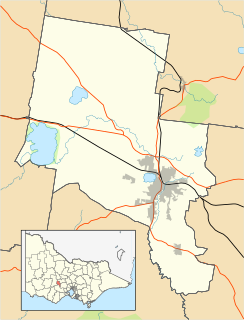
Pterostylis nutans, commonly known as the nodding greenhood or the parrot's beak orchid, is a species of orchid endemic to eastern Australia. Nodding greenhoods have flowers which "nod" or lean forwards strongly, have a deeply notched sinus and a curved, hairy labellum.

Pterostylis curta, commonly known as the blunt greenhood, is a species of orchid found in south-eastern Australia, Lord Howe Island and New Caledonia. It has a rosette of leaves at its base and a single white and green, forward leaning flower with a brown tip and a twisted labellum.

Pterostylis grandiflora, commonly known as the cobra greenhood or superb greenhood, is a species of orchid endemic to south-eastern Australia. As with similar orchids, the flowering plants differ from those which are not flowering. The non-flowering plants have a rosette of leaves but the flowering plants lack a rosette and have a single flower with leaves on the flowering spike. This greenhood has a green and white, striped flower with deep red-brown markings especially on its "galea", and a sharply pointed dorsal sepal.
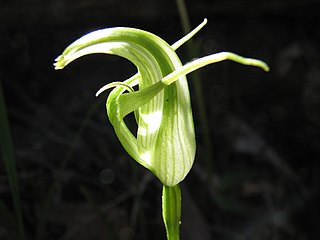
Pterostylis alpina, commonly known as the mountain greenhood, is a species of orchid endemic to south-eastern Australia. It has a rosette of fleshy leaves at the base and usually only one white flower with green markings and back-swept lateral sepals.

Pterostylis baptistii, commonly known as the king greenhood, is a species of orchid endemic to eastern Australia. Flowering plants have a rosette of stalked, dark green leaves and a single white flower with green and brown markings, and a wide gap between the petals and lateral sepals. It occurs mostly in New South Wales but is also found in coastal Queensland and north-eastern Victoria.
Caladenia hastata, commonly known as Mellblom's spider orchid is a plant in the orchid family Orchidaceae and is endemic to Victoria. It is a ground orchid with a single hairy leaf and up to three white to cream-coloured flowers with red markings on the labellum.

Pterostylis chlorogramma, commonly known as the green-striped leafy greenhood, is a plant in the orchid family Orchidaceae and is endemic to Victoria. Flowering plants have up to seven translucent green flowers with darker green stripes. The flowers have a green labellum with a darker stripe down the middle. Non-flowering plants have a rosette of leaves on a short, thin stalk but flowering plants lack the rosette, instead having five to seven stem leaves.
Pterostylis aenigma, commonly known as the enigmatic greenhood is a species of orchid endemic to Victoria. It has a rosette of leaves and a single green and white flower which leans forward and has a brownish point on the end. It is a rare orchid, occurring at only one site with fewer than 100 individual plants and is thought to be a natural hybrid between two species that grow nearby.

Pterostylis despectans, commonly known as the lowly rustyhood, is a plant in the orchid family Orchidaceae and is endemic to south-eastern Australia. It has a rosette of leaves at its base and up to six flowers on long stalks, branching off a short flowering stem. The flowers have an insect-like labellum and often touch the ground.

Pterostylis pedoglossa, commonly known as the prawn greenhood, is a species of orchid endemic to south-eastern Australia. There is a rosette of leaves at the base and flowering plants have a single white flower with green stripes, sometimes with a brownish tinge on the tip, and a long, thread-like labellum.

Pterostylis tenuissima, commonly known as the swamp greenhood, is a species of orchid endemic to the southern mainland of Australia. As with similar greenhoods, the flowering plants differ from those which are not flowering. The non-flowering plants have a rosette of leaves flat on the ground but the flowering plants have a single flower with leaves on the flowering spike. This greenhood has small translucent white flowers with dark green stripes and markings and both the dorsal sepal and lateral sepals have relatively long, thread-like tips.

Pterostylis woollsii, commonly known as the long-tailed rustyhood, is a plant in the orchid family Orchidaceae and is endemic to eastern Australia. It has a rosette of leaves at its base and up to six transparent flowers which have unusually long tips on their lateral sepals and a reddish-brown, insect-like labellum.

Pterostylis falcata, commonly known as the sickle greenhood, is a species of orchid endemic to south-eastern Australia. It has a rosette of bright green leaves at the base of the plant and a single green and white, sickle-shaped flower. It is widespread and often common in Victoria but also occurs further north and west, and in Tasmania
Pterostylis conferta, commonly known as the leprechaun greenhood or basalt midget greenhood, is a plant in the orchid family Orchidaceae and is endemic to Victoria. It has a rosette of leaves at the base of the flowering stem and up to sixteen pale green flowers in a short, crowded spike. It is a very rare orchid, similar to P. mutica, its distribution much reduced by urbanisation and agriculture.
Pterostylis gibbosa, commonly known as the Illawarra rustyhood, or Illawarra greenhood, is a plant in the orchid family Orchidaceae and is endemic to New South Wales. It has a rosette of leaves at its base and up to nine bright green flowers with translucent "windows", relatively wide lateral sepals with short-pointed tips and a dark, fleshy, insect-like labellum.
Pterostylis macrocalymma, commonly known as the large-hooded rufous greenhood or Murchison rustyhood is a plant in the orchid family Orchidaceae and is endemic to the south-west of Western Australia. Both flowering and non-flowering plants have a relatively large rosette of leaves. Flowering plants also have up to ten or more white flowers with bold green or pale brown lines and a broad spoon-shaped, insect-like labellum.

Pterostylis prasina, commonly known as the mallee leafy greenhood, is a plant in the orchid family Orchidaceae and is endemic to southern continental Australia. Non-flowering have a rosette of leaves on a short stalk, but flowering plants lack the rosette and have up to eight pale green and translucent green flowers with darker green lines. The flowers have a pale green labellum with a darker central line. It is a common and widespread greenhood in parts of Victoria and South Australia.
Pterostylis spathulata, commonly known as the spoon-lipped rufous greenhood or Moora rustyhood is a plant in the orchid family Orchidaceae and is endemic to the south-west of Western Australia. Both flowering and non-flowering plants have a relatively large rosette of leaves. Flowering plants also have up to ten or more white and green or brown flowers with fine, upturned tips on the lateral sepals and a spoon-shaped, insect-like labellum.
Pterostylis ziegeleri, commonly known as the Cape Portland greenhood, is a plant in the orchid family Orchidaceae and is endemic to Tasmania. Both flowering and non-flowering plants have a rosette of leaves lying flat on the ground and flowering plants have up to eight crowded translucent, pale green flowers with darker green veins.
Pterostylis oreophila, commonly known as the Kiandra greenhood or blue-tongued greenhood is a species of orchid endemic to south-eastern Australia. Flowering and non-flowering plants have three to five dark green, fleshy leaves and flowering plants have a single green and white, sickle-shaped flower with a deeply notched, bulging sinus between the lateral sepals.







